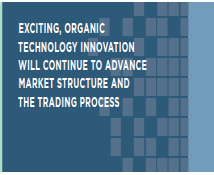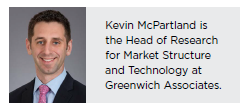The financial crisis, now seven years on, has proven to be an inflection point for countless market structure changes and technology developments. In fact, despite having trend data going back decades, our team rarely uses Greenwich Associates data going back much further than 2007, because nothing before that really matters anymore.
There is no sign the pace of change seen in the post-crisis years will slow in 2016, but the areas of change are diversifying. The U.S. markets are more focused on adapting to the current market structure so they can move forward, whereas the Europeans are bracing for change as the new rules slowly become reality. More broadly, exciting, organic technology innovation continues to move everything forward.
With that, here are our Top 10 Market Structure Trends to watch in 2016.
1 A liquidity crisis does not materialize
Early in 2015, it was in vogue for major market figures to express concern over the looming liquidity crisis created at the hands of low interest rates and shrinking dealer balance sheets. By the end of the year, the cool kids began saying the opposite—that fears of a liquidity crisis were overblown and that liquidity was, in fact, pretty good, all things considered.
In 2016, liquidity will continue to be a topic, without question. However, we remain convinced that the high level of awareness by investors and dealers will ensure that an actual crisis never occurs. Bouts of volatility? Sure. Price gapping? It will happen. But the probability of a full-blown crisis is minimal at best.
2 We stop obsessing about the Fed raising rates
It finally happened, so let’s move on already. Of course even after the Fed’s action in December, interest rates are still insanely low and will continue to be low by historic standards for a few more years. Even if they hike multiple times in 2016, which we expect, the Fed Funds rate will still hover around 1%.
Nevertheless, a move away from post-crisis monetary policy and interest rates above zero is a good thing. While higher rates could slow down bond issuance and other lending, they will ultimately drive an increase in secondary market trading of fixedincome instruments.
New issues will become rarer, driving portfolio managers to look for existing debt to meet their credit exposure needs, and rising interest rates will require a level of hedging that hasn’t existed in years. Both will increase trading volumes and volatility, ultimately increasing dealer profitability. The more profitable trading is for dealers, the more they trade—and the more they trade, the more liquidity the market will enjoy. See trend No. 1.
3 Full service dealers dwindle
Despite signs that market conditions will improve in the coming years, we continue to see major banks exit certain business lines as they struggle with rising costs and declining profit margins. In many cases, they have no choice. No public company (or private one for that matter) can justify staying in a hypercompetitive, unprofitable business because it’s always been that way or they think it will get better eventually.
However, history tells us that most of these markets will see conditions improve over time, and banks that are getting out now will likely be itching to get back in when that day arrives. Those banks that are sticking with it despite a tough environment are the ones that will be in a dominant position in the long run.
4 We stop talking about HFT and start talking about non-bank liquidity
It was refreshing to hear a Fed employee point out at a conference this fall that high-frequency trading is not a strategy or firm type, but instead, a technology. High-speed trading techniques are used by banks, hedge funds and even a few asset managers—not just principal trading firms.
But semantics aside, the point here is that increasingly tough bank oversight is opening the door for non-bank liquidity providers, regardless of the technology they use to trade. Keep an eye out for non-bank broker-dealers, quantitative hedge funds, traditional investors interacting with one another anonymously via a trading platform, and (of course) principal trading firms.
5 Tech-enabled sales traders thrive
Market structure enthusiasts love to talk about the growth of electronic trading in all of its forms, Greenwich Associates included. But we’ve also spent quite a bit of time over the past two years researching the role of the sell-side sales desk.
Our conclusion is also our prediction for 2016—relationship management via the sales function is critical to the health of the franchise.
Unfortunately, it is not as simple as continuing to take your clients to steak dinners and baseball games. And even if it were, each sales person now covers so many accounts compared to 10 years ago that the old way would require eating steak eight nights a week. Managing relationships going forward will require a better-rounded individual using increasingly sophisticated technology. Machine learning and cognitive computing are coming to the trading desk.
6 Shakeout for corporate bond platforms
Our 2015 top trends discussed the slew of new platforms that would go live, the new trading protocols that would be adopted and the slow growth of corporate bond e-trading. All of those things did, in fact, happen.
In 2016 we expect the latter two trends to continue, with our latest data showing e-trading by notional volume continuing to grow and client interest in auctions and all-to-all trading expanding. But when it comes to new platforms launching, we expect the number of starts to be less than the number of ends in 2016, with mergers and divestitures likely. Expect the big to get bigger, those that already have some traction to see it improve, and any new successes to come from offerings that tackle the market in more unique ways than simply matching buyers and sellers.
7 Regulators leave the bond market alone
Washington has done a lot of talking over the past year about bond market liquidity and preventing another “flash crash.” They’ve gone so far as to do some pretty detailed research into the matter as well. However, they’ve stopped short of actually proposing or implementing any real change to the bond market, and we don’t expect them to do so in 2016 either.
The low-hanging fruit for regulators is a post-trade reporting requirement for U.S. Treasury trades and additional registration requirements for bond-trading platforms and, potentially, liquidity providers. But with no single regulator focused on these markets (the Treasury market is overseen by four government bodies, for instance), it is unlikely anyone will create, promote and pass a new rule in the foreseeable future—unless another market crisis prompts them to do so.
8 Clearing grows while profit margins shrink
European clearing mandates are finally set and due to take effect in June of 2016. European swaps rules coming in line with those already in place in the U.S. will boost clearing adoption globally. Yet while regulators around the world will cheer this progress toward the G20 goals set almost seven years ago, swaps clearing members are crying foul, as the current patchwork of rules around the world has made offering this service a lackluster business at best.
As a result, much-touted new entrants that came into clearing after Dodd-Frank was passed in 2010 are now out, and swaps clearing in the U.S. is now more concentrated among a smaller number of dealers than swaps trading. This is not something regulators should be cheering about.
9 The chat conversation gets real
We talked about this one last year looking ahead to 2015, and it’s as hot now as it was then. But we believe the conversation over the past year has been a bit misguided, focused on front-office chat, which is only a small piece (albeit an important one) of the disruption in progress.
First, the front-office part: Contrary to popular belief, the capital markets industry is more than just traders and portfolio managers. In fact, the rest of the market—technology, operations, legal, compliance, business analysts, et al—represents a much bigger user base than the front office. Granted the front office generates the revenue and, hence, sets the direction. But the size of the rest of the market can’t be ignored.
Then comes that chat piece: Instant messaging makes you think of AOL in the ‘90s. The conversation in financial markets today is about collaboration, compliance and integration. This means the ability to work with colleagues, clients and service providers in an efficient and compliant way regardless of location, and in such a way that the collaboration tool works seamlessly with the other technology used by the individual.
The bottom line for 2016: The focus will move beyond chat and the front office, incorporating integration, compliance and collaboration into the conversation.
10 The blockchain buzz continues
And what would a market structure top 10 be without talk of the blockchain (aka, distributed ledger technology). The buzz went from zero to 60 in just a few months, becoming a hot topic so quickly that it didn’t even receive a passing mention in what we wrote last year.
But don’t let the buzz trouble you—there is some really fascinating innovation going on under the blockchain umbrella that will help market participants save money and reduce risk. The road to those lofty goals will be long and winding, however, and the use cases that seem obvious today are likely not the ones that will ultimately have the biggest impact.
The next year will be one of innovation and attempts at disruption, although earth-shattering change is still a few years off. Whether that change comes from Satoshi’s blockchain or from a solution found by accident is irrelevant—what matters is that the smartest minds in the fintech world are fighting to improve processes in desperate need of innovation.



